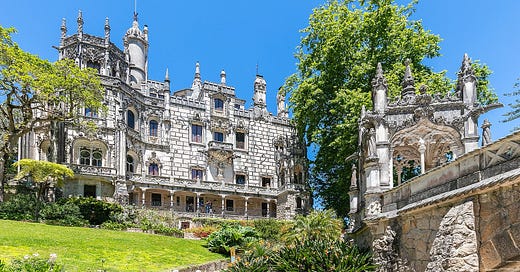Sintra council halves number of visitors to Quinta da Regaleira
The measure will come into effect in September.
Facing growing protests against mass tourism, Sintra Council has announced plans to halve the limit of 9,000 daily tourists at Quinta da Regaleira, managed by the CulturSintra Foundation.
‘From September this year, the maximum number of visitors to this monument will be reduced by 50 %, i.e. a halving of the number of daily tourists currently allowed to visit this monument,’ the municipality told ECO/Local Online.
With these decisions, the council aims to strike a ‘balance between the benefits of tourism and mitigating the effects of the increase in national and international tourism, and the impact of this reality on the historic centre’ of the town.
The municipality points out THAT “the reduction in the number of daily visits to the National Palace of Pena [this year] was a strategic option imposed by proactive measures”.
The monument once registered 12,000 visitors in a single day.
“The limitation to half that figure [12,000 visitors], imposed at the beginning of 2024, guaranteed an improvement in the visitor experience and a reduction in the rate of heritage degradation due to high tourist pressure,” he emphasises.
As a result, the Pena National Palace, under the management of Parques de Sintra, saw a drop of 16.5% this year compared to 2023.
According to the local authority, these two monuments are among the most visited in Portugal and “their location on the Sintra mountain range/historic town axis is at the root of the main daily problems of tourist pressure”.
Hence the need to implement “these measures at the Pena National Palace and Quinta da Regaleira, which have a profound impact on the tourist pressure that is felt daily in the town's historic centre and surrounding areas”.
Despite the steady upward trend in visitors in recent years, “Parques de Sintra [one of the city’s main cultural/tourism organisations] saw a drop in sales in the first few months of 2024,” the municipality calculates.
This, it points out, “contradicts the increase that had been occurring in the post-Covid-19 pandemic period’ and which ‘continues to occur in other similar destinations”.
As of 15 July 2024, Parques de Sintra had sold more than 1.7 million tickets, 3% less than in the same period in 2023. That was the year in which the monuments managed by Parques de Sintra received more than 3.3 million visitors.
“The municipality has implemented measures to reduce the tourist load on Sintra’s main cultural monuments, reinforcing the quality and diversity of the cultural/tourist offer, and the attractiveness of the potential of the cultural and natural heritage for other sectors of activity alternative to tourism,” it points out.
This strategy is being implemented in conjunction with the main organisations involved in the tourism/cultural sector, publicising the breadth of Sintra’s tourism as well as “the obvious routes that cause high pressure, particularly in the historic town”.
Regarding measures to mitigate traffic pressure in the town of Sintra, the municipality has already restricted car traffic in the historic centre.
It says that “this has proved to be an important measure to improve the enjoyment of this World Heritage site and increase the quality of life of its inhabitants”.
Nonetheless, residents and shopkeepers continue to complain.
Among the measures to mitigate the consequences of the tourist pressure felt, the municipality lists the construction of a car park on the outskirts of Portela de Sintra station, with capacity for 550 vehicles.
The new Ramalhão 1 car park - at the end of the IC19 and next to Sintra’s main entrance - is under construction, which will accommodate vehicles and motorhomes, as well as the Ramalhão 2 car park, in the same location, which will allow 500 vehicles to be parked.
Another strategy that has not yet seen the light of day is the regulation of tourist vehicles, namely Tuk-Tuk.
The measure would provide for the creation of a quota for the number of vehicles to circulate, as well as differentiating between electric and combustion engine vehicles.
However, :due to a court decision, which has since been appealed by the municipality, it was not possible to implement it,” the municipality notes.




